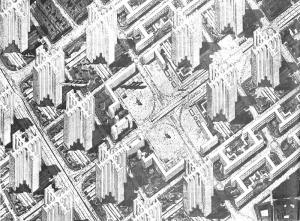Garden City: a style of planning that was started in 1898 by Sir Ebenezer Howard. Garden cities are contained communities surrounded by greenbelts containing houses, businesses, and agriculture. They were meant to help in economic reform where the tenants would pay money back to the community. Garden cities offered a mix of urban and country living, in which the two are separated by green lands. These communities were meant to be smokeless and slum-less.
Radiant City: Architect Le Corbusier developed the idea for radiant cities in the 1920s. He attempted to mix industrial architecture with nature by creating buildings that were supported by stilts, so they wouldn’t interfere with nature. He planned to section the city off into subsections, residential in one area, business offices in another, etc. His influences carried on to have much impact on our modern cities today.
Garden City vs Radiant City:
Garden Cities were meant to split urban areas up and scatter them throughout nature, while Radiant cities were meant to integrate industrial architecture with nature.
Garden Cities were intended to have residential houses near parks and green areas, while Radiant cities would house tall residential buildings spread about from each other.
Opinion: I would much rather live in a Garden city community because I feel like I would be much too cramped in a Radiant city. Sure, they provide a lot of light and are in a park themed area, but it would feel much better to live in your own community near the country, but also close to the city a short distance away. The Garden city reminds me more of Charlottetown than a Radiant city would, which is why I like it more.
Success or Failure: Garden cities succeeded much more than Radiant cities did. Most cities nowadays follow Garden city layouts because they are based around one specific point, or town centre, and expand outwards to suburbs. Radiant cities are less appealing to the public because of their industrious look and inner city feel.



